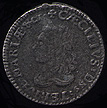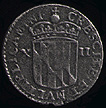Lord Baltimore Coinage 1658-1659
Original Sixpence
obverse |
|
reverse |
| |||
[1659] 6d variety 2-B Lord Baltimore sixpence
Obverse: + CAECILIVS : DNS: TERRAE MARIAE : & C.
Reverse: + CRESCITE : ET : MVLTIPLICAMINI
Weight: 41.5 g (2.69 grams) Diameter: 21.5 mm Reverse die alignment: 180°
Comments: This is an original Baltimore sixpence, from the hoard of nineteen examples that recently came to light in the estate of Mary Fry. The coins were discovered in a small silver cylinder at her parent's family estate (the Fane family) called Fulbeck Hall in Lincolnshire, England. The details of the hoard find are in the Morton and Eden catalogue, unpaginated but includes the front cover, the page before lot 767 and the three pages containing lots 767-786.
The obverse is the small bust variety called obverse B. Diagnostics of this obverse include the recut first I in CAECILIVS and two small die cracks following the colon after CAECILIVS. The reverse is die B, the point of the shield is between M and V, there is a cutting error between the C and the A in MVLTIPLICAMINI and there is no stop following the final I.
Provenance: Acquired through the Robert H. Gore, Jr. Numismatic Endowment from the Morton and Eden auction of Ancient, British and World Coins, War Medals and Decorations, Historical Medals, Banknotes, held in London, November 13-14, 2002, lot 774.
Denarium (Idler reproductions)
obverse |
|
reverse |
| |||
[1860] Kenney - Idler 2 bronze Idler copy - Lord Baltimore Denarium
Obverse: + CAECILIVS : DNS: TERRAE MARIAE : & CT . /
W. IDLER, DEALER IN COINS, MINERALS &c PHILA
Reverse: + DENARIVM : TERRAE - MARIAE
Weight: 76.5 g (4.96 grams) Diameter: 20.6 mm Reverse die alignment: 360°
Comments: This is a copy of the Baltimore "denarium" or penny made about 1860 by William Idler of Philadelphia. The original denarium was made of copper and only produced as a pattern. It was never put into production and only five examples are known. The rather common Idler reproductions come in various metals, this example being in bronze. The different metals can easily be distinguished as they all have different weights (listed in Kenney); for example, the bronze copy weighs about 4.96 grams while the copper version is slightly heavier at 5.12 grams.
The obverse differs from the original in that the portrait is somewhat different, especially in the hair area, and the legend ends with CT while the original has only the C. Of course Idler's advertisement is not found on the original but is sometimes removed from the copy. The reverse only differs from the original in minor stylistic details (eg. on the original the flags are closer to the top of the poles; on originals the pole top ends with a small ball to which the diamond shaped ornament is attached while in the copy the ornament is directly attached to the pole without the ball).
Provenance: From the Robert H. Gore, Jr. Numismatic Collection.
obverse |
|
reverse |
| |||
[1860] Kenney - Idler 2 nickel Idler copy - Lord Baltimore Denarium
Obverse: + CAECILIVS : DNS: TERRAE MARIAE : & CT . /
W. IDLER, DEALER IN COINS, MINERALS &c PHILA
Reverse: + DENARIVM : TERRAE - MARIAE
Weight: 58.0 g (3.76 grams) Diameter: 20.5 mm Reverse die alignment: 360°
Comments: This is a copy of the Baltimore "denarium" or penny made about 1860 by William Idler of Philadelphia. The original denarium was made of copper and only produced as a pattern. It was never put into production and only five examples are known. The rather common Idler reproductions come in various metals, this example being in nickel. The different metals can easily be distinguished as they all have different weights (listed in Kenney); for example, the brass copy weighs about 4.60 grams while the nickel version is about 3.63 grams.
The obverse differs from the original in that the portrait is somewhat different, especially in the hair area, and the legend ends with CT while the original has only the C. Of course Idler's advertisement is not found on the original but is sometimes removed from the copy. The reverse only differs from the original in minor stylistic details (eg. on the original the flags are closer to the top of the poles; on originals the pole top ends with a small ball to which the diamond shaped ornament is attached while in the copy the ornament is directly attached to the pole without the ball).
Provenance: From the Robert H. Gore, Jr. Numismatic Collection.
Shilling (reproduction)
obverse |
|
reverse |
| |||
UNDATED Modern copy of a Lord Baltimore Shilling
Obverse: + CAECILIVS : DNS : TERRAE - MARIAE : & CT .
Reverse: CRESCITE : ET : MVLTIPLICAMINI . / X II
Weight: 134.3 g (8.70 grams) Diameter: 26.25 mm
Comments: This is a modern copy of the Baltimore shilling made of lead, quite close to the original.
Provenance: Loaned for inclusion on this web site by an anonymous collector.
| Sommer Islands "Hogge Money" | Section Contents | St. Patrick Coppers |
|
For viewing tips and information on optimal computer settings click
here.
For questions or comments contact Special Collections by: |







